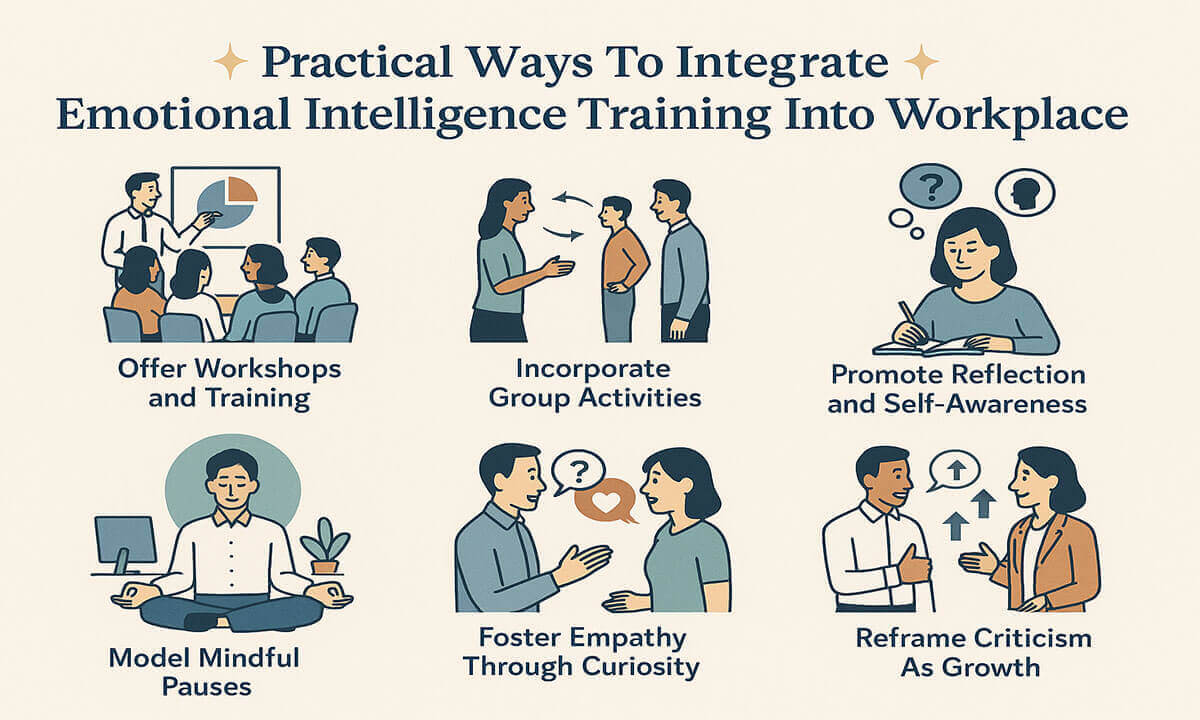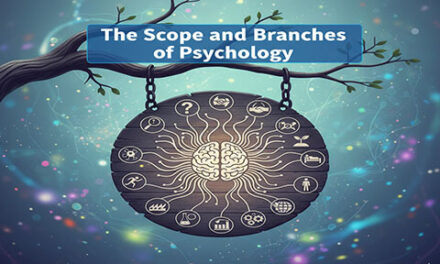Practical Ways to Integrate Emotional Intelligence Training Into the Workplace:
Integrating emotional intelligence into workplace culture is increasingly recognized as an essential practice for organizations that want to thrive in today’s competitive and complex environment. When employees are equipped with emotional intelligence skills, they are able to communicate more effectively, resolve conflicts with greater empathy, and contribute to a supportive environment that values growth and resilience. Research highlights that emotional intelligence in professional settings improves collaboration, fosters empathy, and builds a resilient culture that encourages both individual and organizational success (Hasson, 2014). Emotional intelligence also creates a safe space for giving and receiving feedback without defensiveness. This environment stimulates psychological safety, which is vital for innovation and long-term growth. By embedding emotional intelligence into workplace training, organizations not only enhance employee well-being but also strengthen productivity and adaptability in the face of change. According to Andreev (2025), there are several practical ways to integrate emotional intelligence training into the workplace.
1. Offer Workshops and Training: Workshops and structured training sessions are one of the most direct ways to introduce emotional intelligence into the workplace. These sessions allow employees to actively engage with concepts such as emotion regulation, perspective taking, and effective communication. For example, participants can be guided through activities where they practice identifying their own emotions in challenging scenarios and learn how to manage those emotions in healthier ways. When these skills are taught systematically, employees gain practical tools to handle stress, resolve conflicts, and build stronger interpersonal relationships. Training also sends a strong signal that the organization values the development of its people, which in turn fosters loyalty and motivation. Over time, consistent training can transform workplace culture by normalizing empathy, collaboration, and constructive communication.
2. Incorporate Group Activities: Group activities are another powerful method to develop emotional intelligence because they provide opportunities for experiential learning. Employees are not just told what emotional intelligence looks like but are given the chance to practice it together. Role-play exercises, for instance, allow participants to step into another person’s perspective and imagine how different responses might feel in emotionally charged situations. Card decks and scenario-based tasks can also challenge teams to think critically about how emotions influence behavior, decisions, and teamwork. These activities promote collaboration and help colleagues develop empathy by better understanding one another’s experiences. As groups participate in these exercises, they build trust, improve their ability to read social cues, and strengthen their capacity for teamwork.
3. Promote Reflection and Self-Awareness: Self-awareness is a cornerstone of emotional intelligence, and workplaces that encourage reflection give employees the tools to understand themselves more deeply. Journaling, guided reflection, or regular debrief sessions after meetings can help individuals process their emotional reactions and identify recurring patterns. For example, an employee who notices that certain feedback consistently triggers frustration can work on strategies to manage this response. Over time, these reflective practices allow employees to recognize their emotional triggers, understand how their reactions affect others, and make more thoughtful choices in future interactions. A workplace that fosters this kind of self-awareness not only supports individual growth but also enhances overall harmony within teams, as employees become more mindful of their words, actions, and emotional impact.
4. Model Mindful Pauses: In many workplaces, employees feel pressure to respond quickly to emails, questions, or conflicts, which often leads to rushed and reactive decisions. Teaching staff to practice mindful pauses can make a significant difference in these situations. A mindful pause involves taking a brief moment to breathe, reflect, and consider the best way to respond before speaking or acting. For instance, during a heated discussion, an employee who takes a few seconds to pause is more likely to respond calmly rather than escalate the tension. This practice encourages thoughtfulness, reduces misunderstandings, and fosters a culture of patience and respect. Leaders who demonstrate mindful pauses in high-pressure meetings or negotiations set a clear example that slowing down can actually improve outcomes rather than hinder them. Over time, this habit becomes part of the organizational rhythm, leading to more constructive and emotionally intelligent interactions.
5. Foster Empathy Through Curiosity: Empathy is at the heart of emotional intelligence, and one of the most effective ways to cultivate it is through curiosity. Encouraging employees to ask questions such as “What might this person be experiencing?” or “What could be driving this behavior?” helps shift focus away from assumptions and toward understanding. When people approach interactions with curiosity, they are more likely to interpret difficult behaviors as signals of underlying stress, needs, or concerns rather than personal attacks. For example, a manager might notice that an employee is unusually withdrawn and, instead of criticizing their lack of participation, ask what challenges they might be facing. This approach fosters trust, strengthens relationships, and reduces conflict. A culture that values curiosity creates space for compassion, making the workplace more supportive and collaborative.
6. Reframe Criticism as Growth: Feedback is often one of the most emotionally charged aspects of workplace life, yet it is essential for improvement and success. When employees perceive feedback as criticism, it can lead to defensiveness and disengagement. However, reframing feedback as an opportunity for growth transforms the way it is received and applied. Leaders play an especially important role here. By modeling resilience and openness when receiving feedback themselves, they show that feedback is not a personal attack but a valuable tool for learning. For instance, a leader who thanks their team for constructive suggestions and explains how they will apply them demonstrates emotional maturity and sets a positive tone. When this mindset spreads across the workplace, employees begin to view feedback as a normal and even welcome part of their development. This cultural shift creates a supportive environment where learning and continuous improvement are celebrated.
In conclusion, emotional intelligence is not an innate trait but a skill that strengthens with consistent practice. By normalizing empathy, reflective habits, and effective communication, workplaces can make emotional intelligence an integral part of everyday interactions. Organizations that invest in emotional intelligence training are better positioned to cultivate resilience, support innovation, and foster a positive culture where both employees and the organization as a whole can flourish (Hasson, 2014; Andreev, 2025).
Frequently Asked Questions (FAQs):
Why is emotional intelligence important in the workplace?
Emotional intelligence is important because it helps employees manage stress, communicate effectively, and build stronger relationships. When individuals are more aware of their emotions and the emotions of others, they can respond thoughtfully instead of reacting impulsively. This leads to a more supportive workplace culture and better overall performance.
Can emotional intelligence actually be taught?
Yes, emotional intelligence can be developed through practice and training. While some people may naturally display higher levels of empathy or self-awareness, structured programs such as workshops, reflective exercises, and role-play activities allow everyone to strengthen these skills over time.
How does emotional intelligence training benefit teams?
Teams benefit because emotional intelligence training promotes trust, empathy, and collaboration. Members learn to understand one another’s perspectives, manage conflicts constructively, and communicate more clearly. This not only reduces misunderstandings but also increases productivity and creativity.
What role do leaders play in promoting emotional intelligence?
Leaders are central to creating a culture of emotional intelligence. When leaders model behaviors such as pausing before reacting, reframing feedback as growth, and showing empathy during conflicts, employees are more likely to adopt the same practices. Leadership sets the tone for how emotional intelligence is valued within an organization.
How can employees practice emotional intelligence daily?
Employees can practice emotional intelligence by reflecting on their emotions, seeking to understand the feelings of others, and using curiosity rather than judgment when faced with challenging behavior. Simple habits such as journaling, asking open-ended questions, or taking mindful pauses before responding are small but powerful ways to strengthen emotional intelligence every day.
Does emotional intelligence improve job satisfaction?
Yes, workplaces that prioritize emotional intelligence often see higher job satisfaction. When employees feel heard, respected, and supported, they are more motivated and engaged in their work. This creates a positive cycle where happier employees contribute to a healthier workplace environment.
References:
- Andreev, I. (2025). Emotional intelligence in the workplace: Importance & components. Valamis. Retrieved August 11, 2025, from https://www.valamis.com/hub/emotional-intelligence-in-the-workplace
- Hasson, G. (2014). Emotional intelligence: Managing emotions to make a positive impact on your life and career. John Wiley & Sons.

Library Lecturer at Nurul Amin Degree College










